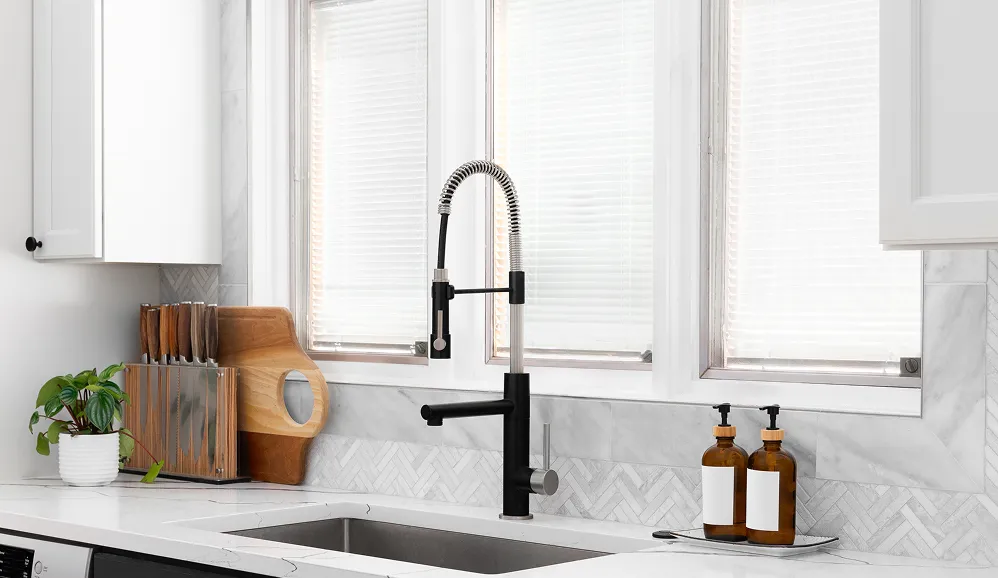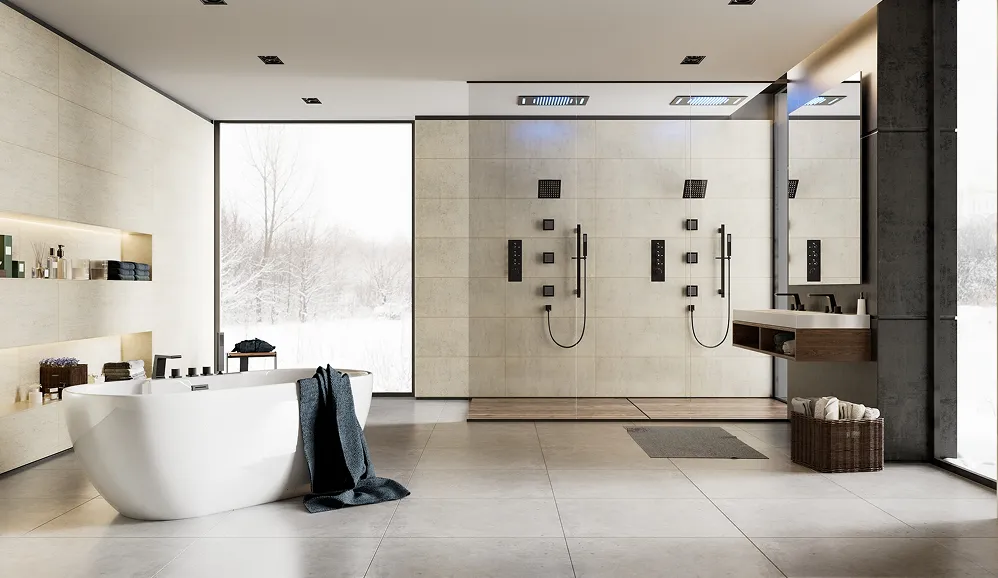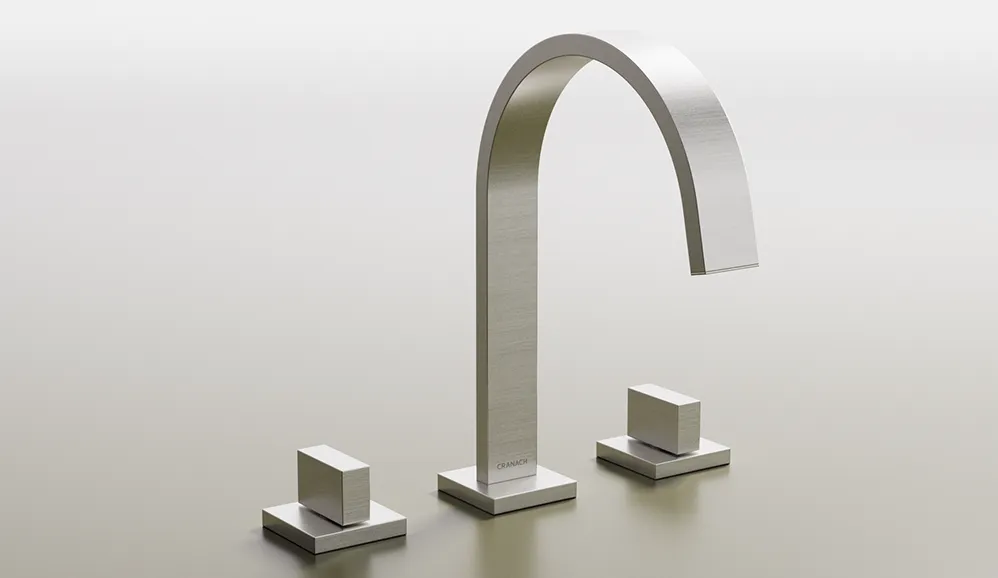Stepping out of the shower and seeing little rolled-up bits of skin can be a bit weird, but it’s usually a perfectly normal—and even healthy—process. The warmth and steam from your shower simply soften the very top layer of your skin, making its natural shedding cycle much more obvious. This is just your body’s way of renewing itself, not a sign that something is wrong.
Why Dead Skin Shows Up More After a Shower
The sight of flaky skin after a warm bath or shower often makes people wonder why so much seems to come off at once. The answer is a completely natural biological process called desquamation.
Think of it like a snake shedding its skin, but on a microscopic, continuous scale. Your body is constantly getting rid of old skin cells to make way for the new, healthy ones underneath. It’s a non-stop renovation project.
Your body is remarkably efficient at this. In fact, it sheds roughly one million skin cells every 24 hours, which comes out to about 30,000 to 40,000 cells per hour. This turnover is crucial for keeping your skin looking and feeling healthy.
When you shower, the combination of warm water and steam softens that top layer of skin (the epidermis). This loosens the dead cells that were already ready to fall off. Then, the simple friction from washing with a cloth or drying with a towel rolls these softened cells together, making them way more noticeable than when they fall off invisibly throughout the day.
The Science of Skin Shedding
To get a better picture of what’s happening, this infographic breaks down the key facts about your skin’s renewal process.
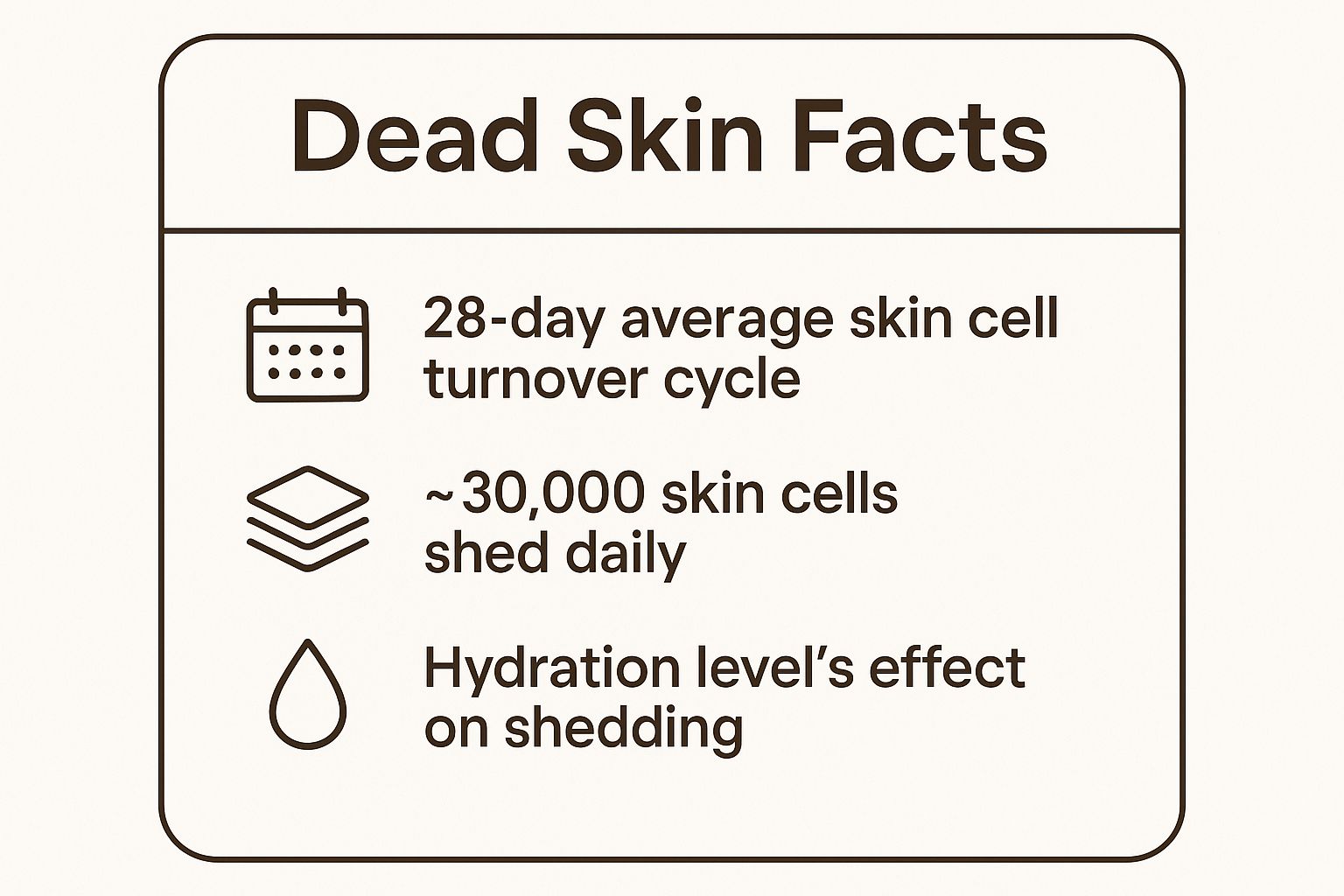
As you can see, your skin’s renewal cycle and daily shedding are completely normal, but how hydrated your skin is can really affect how smoothly this all goes down.
A few common things can make this shedding even more prominent. Understanding what they are can help you manage your skin’s health better and turn your daily wash into a genuinely beneficial ritual. You might even be interested in learning about the wellness shower as a unique approach to cleansing.
To make it simple, let’s look at the main reasons you might be seeing more dead skin after you shower.
Common Reasons for Visible Dead Skin After Showering
The table below breaks down the most common culprits that contribute to seeing more dead skin after showering. It’s a quick way to spot what might be causing it and what you can do about it.
| Factor | How It Contributes to Dead Skin | Quick Fix |
|---|---|---|
| Hot Water Temperature | Strips your skin’s natural oils, leading to dryness and more flaking. | Use lukewarm water instead of steaming hot. |
| Skin Type | Naturally dry or sensitive skin is just more prone to visible flaking. | Moisturize immediately after showering while skin is damp. |
| Harsh Soaps | Can disrupt the skin’s pH balance and protective barrier, causing irritation. | Opt for a gentle, hydrating cleanser that doesn’t strip your skin. |
| Infrequent Exfoliation | Allows a buildup of dead cells that then come off all at once. | Gently exfoliate 1-2 times per week to keep things smooth. |
By paying attention to these factors, you can easily adjust your routine to keep your skin healthy, smooth, and comfortable. It’s all about working with your body’s natural processes, not against them.
How Your Shower Routine Impacts Your Skin
Your daily shower does a lot more than just get you clean; it has a profound effect on your skin’s health. While it feels incredible to stand under the spray, some common habits can actually work against you, stripping your skin of its natural defenses and leading to the very flaking you’re trying to prevent.
Think of your skin’s outermost layer as a brick-and-mortar wall. The bricks are your skin cells, and the mortar is a mix of natural oils (lipids) that hold everything together. This “moisture barrier” is your personal shield, designed to keep hydration in and irritants out.
So, when you indulge in a long, hot shower, you’re essentially melting that protective mortar away. This is a huge reason why you might see so much dead skin after a shower. Once those oils are gone, your skin can’t hold onto moisture, it gets dry, and the dead cells on top start to clump and flake off.
The Problem with Hot, Long Showers
Two of the biggest culprits here are water temperature and how long you stay in. Dermatologists often recommend keeping showers between 5 and 10 minutes. Anything longer, especially with hot water, starts to really compromise that delicate moisture barrier.
Key Insight: A hot shower feels great because it opens your pores and softens the skin. But it also strips away sebum—the natural, waxy oil that moisturizes and protects you. This is exactly why your skin often feels tight and dry after a hot bath or shower.
This problem gets even worse in the winter. You’ve got cold air outside and dry, heated air inside, so your skin is already fighting an uphill battle to stay hydrated. A scalding shower can be the final straw, pushing it into a state of extreme dryness and flaking. Interestingly, switching things up might help; you may want to explore the benefits of a cold shower, which can improve circulation and boost skin resilience.
The Role of Hard Water and Your Shower System
It’s not just about what you do in the shower—what comes out of the shower head matters, too. If you live in an area with hard water, your water is full of minerals like calcium and magnesium. This isn’t just bad for your pipes; it leaves a film on your skin.
That mineral residue can clog pores, throw your skin’s pH balance out of whack, and contribute directly to dryness and irritation. It’s an invisible problem with very visible consequences.
This is where a high-quality shower system can be a game-changer. Think of upgrading your shower as a direct investment in your skin. A premium CRANACH shower system gives you the precise temperature and flow control you need to cleanse your skin gently, without stripping it bare. A clean fixture is also essential for a healthy shower; our guide on how to clean a shower head with vinegar can help you keep it in top shape.
Recognizing When Flaking Is a Deeper Issue
A little bit of skin flaking off after a hot shower is totally normal. But what if it’s constant? Or what if the peeling seems excessive? Sometimes, this is your skin’s way of sending up a flare, telling you there might be something more going on beneath the surface. It’s important to know the difference between your skin’s regular renewal cycle and symptoms that point to a bigger problem.
Most of the time, the answer to “why so much dead skin after showering?” is just your body doing its thing. If that flaking comes with redness, intense itching, thick, scaly patches, or any real discomfort, though, it’s likely more than just a simple case of dry skin. These are often clues that a skin condition is throwing your cell turnover process out of whack.
When Normal Shedding Becomes a Concern
Certain health conditions can put your skin’s renewal system into overdrive, causing it to speed up way too much. The result is a fast and furious pile-up of dead cells on the surface, which then shed in very noticeable, sometimes thick, flakes.
Conditions like eczema, psoriasis, and ichthyosis vulgaris are common culprits. They don’t just make your skin dry; they fundamentally change how your skin behaves.
Important Distinction: The normal dead skin you rub off feels like fine, crumbly little bits. Peeling from a medical issue often looks different—think larger, sheet-like flakes, frequently paired with inflammation or irritation.
This kind of abnormal shedding, a process technically known as desquamation, can be triggered by a whole range of things, from specific illnesses to UV sun damage. For example, disorders like psoriasis can cause hyperkeratosis, where dead cells don’t just shed invisibly but clump together into obvious scales.
Understanding Common Skin Conditions
Knowing what to look for can help you decide when it’s time to call in a professional. Here are a few conditions that are well-known for causing excessive flaking:
- Psoriasis: This is an autoimmune condition that puts skin cell production into hyper-speed. It leads to those tell-tale thick, silvery scales and red, inflamed patches.
- Eczema (Atopic Dermatitis): Eczema weakens the skin’s natural barrier. This leaves it dry, itchy, and inflamed, which almost always results in flaking and peeling.
- Ichthyosis Vulgaris: A genetic condition that messes with your skin’s natural shedding clock, slowing it down. Dead cells can’t shed properly, so they build up into dry, thick scales that can look a bit like fish scales.
If you have a gut feeling that something more is going on, please don’t try to diagnose it yourself or scrub the flakes away aggressively. That can make everything much worse. Your best bet is always to consult a dermatologist. They can figure out exactly what’s happening and map out a treatment plan that’s right for your skin.
It’s also smart to make sure your shower setup isn’t adding to the irritation. Something as simple as poor water pressure can affect your shower experience. If you think that might be a factor, it could be worth learning how to increase water pressure in a shower to see if it helps.
Your Action Plan for Achieving Smoother Skin
Turning your shower into a skin-smoothing ritual is a lot easier than you might think. It’s really about building a consistent routine with the right steps and tools. You’re moving beyond just getting clean to actively caring for your skin. This simple plan breaks it all down into manageable steps for pre-shower, in-shower, and post-shower care.
Pre-Shower Preparation
Your journey to smoother skin actually starts before you even turn on the water. One of the most effective pre-shower rituals you can adopt is dry brushing.
Using a natural bristle brush on dry skin, you’ll want to start at your feet and brush upwards toward your heart in long, smooth strokes. This simple practice helps to:
- Loosen dead skin cells before they get wet, which makes them much easier to wash away later.
- Boost circulation, bringing more oxygen and vital nutrients right to your skin.
- Stimulate the lymphatic system, which helps your body clear out toxins.
Think of it as a gentle warm-up for your skin. Just a few minutes of dry brushing, two or three times a week, can make a huge difference in your skin’s texture and overall tone.
In-Shower Exfoliation and Cleansing
Once you’re in the shower, the focus shifts to gentle cleansing and smart exfoliation. This is where you tackle the core issue of why so much dead skin comes off after a shower by actively managing that shedding process.
You have two main types of exfoliants to choose from:
- Physical Exfoliants: These are your scrubs, loofahs, or washcloths that manually buff away dead cells. They give you that immediate satisfaction but should always be used gently to avoid creating micro-tears in the skin.
- Chemical Exfoliants: These use acids like AHAs (alpha-hydroxy acids) or BHAs (beta-hydroxy acids) in body washes to dissolve the “glue” that holds dead skin cells together. They offer a more even, less abrasive kind of exfoliation.
For most of us, exfoliating 1-2 times per week is more than enough. If you overdo it, you can strip your skin and damage its protective barrier, which ironically leads to more irritation and dryness.
Pro Tip: The quality of your shower itself plays a huge role. A well-designed shower system isn’t just a luxury; it’s a fundamental skincare tool. It allows you to control water pressure and temperature with precision, creating the perfect environment for gentle, effective cleansing without stripping your skin.
The right CRANACH shower system can transform your daily wash into a true skin-care ritual.
Having a system with multiple spray settings and reliable temperature control empowers you to customize your shower for your skin’s specific needs each day. And if you’re dealing with inconsistent water flow that’s getting in the way of a good rinse, you might find it helpful to learn how to increase water pressure in your shower.
Post-Shower Hydration
This last step is arguably the most important one. After you turn off the water, you have a golden window of opportunity to lock in moisture.
- Pat, Don’t Rub: Gently pat your skin with a soft towel, leaving it just a little damp. Aggressively rubbing can cause unnecessary irritation.
- Moisturize Immediately: Apply a generous amount of lotion or body cream to your damp skin within three minutes of getting out. This helps trap the water on your skin’s surface, giving you deep, lasting hydration.
By following this simple, three-part plan, you can finally take control of your skin’s shedding cycle and achieve the smooth, healthy skin you’re looking for. Remember, consistency is what brings success.
The Link Between Nutrition and Skin Health
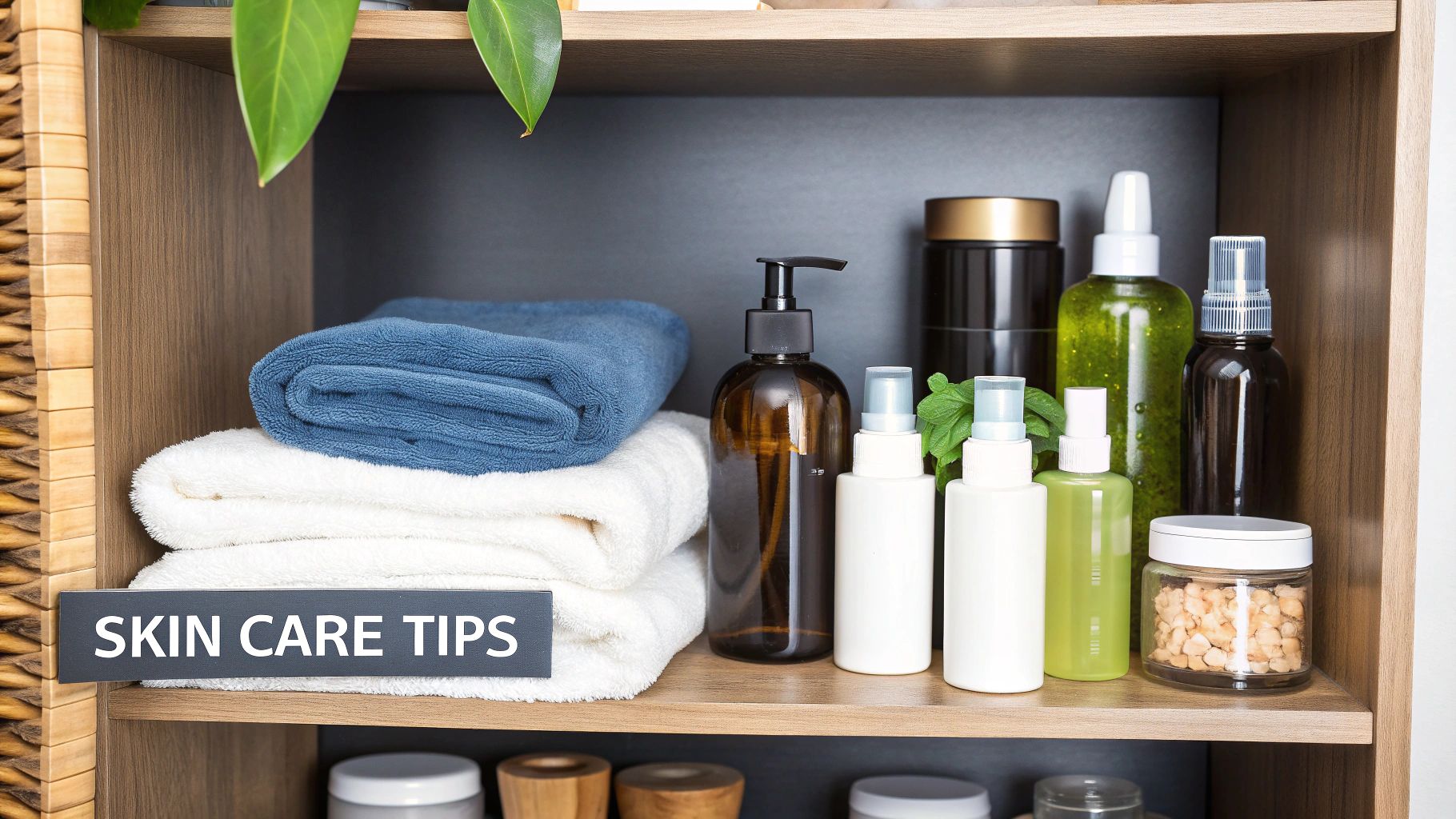
While the right shower routine and skincare products make a world of difference for flaky skin, they’re only half the story. The honest truth is that glowing, healthy skin is built from the inside out. What you eat and drink has a direct impact on your skin’s natural ability to renew itself.
Think of your skin cells as tiny, individual balloons. When you’re properly hydrated, those balloons are full and plump, giving your skin that smooth, elastic look we all want. But when dehydration kicks in, they start to deflate, becoming saggy and much more prone to wrinkling and flaking. This is why one of the simplest, yet most effective, ways to combat dry skin is just drinking enough water.
Nourishing Your Skin From Within
Beyond H2O, certain nutrients are the literal building blocks for healthy skin. They supply the raw materials your body needs for cell repair, regeneration, and protection against daily environmental stressors. A diet packed with these nutrients can make a visible difference in how your skin looks and feels.
Some foods are just loaded with compounds that support skin health. Working them into your meals is a proactive way to get to the root cause of dryness and irritation, which can help reduce why you see so much dead skin after a shower.
For instance, chronic inflammation is a major culprit behind many skin issues. It’s often beneficial to incorporate foods that fight inflammation into your diet to calm things down from the inside.
Key Nutrients for a Healthy Glow
To really give your skin the support it craves, try to get these nutritional powerhouses onto your plate:
- Omega-3 Fatty Acids: You’ll find these healthy fats in foods like salmon, walnuts, and flaxseeds. They’re absolutely essential for maintaining a strong skin barrier, helping to lock moisture in and keep irritants out.
- Antioxidants: Berries, leafy greens like spinach, and even dark chocolate are full of antioxidants. These amazing compounds fight off free radicals—unstable molecules that damage skin cells and speed up the aging process.
- Vitamin C: This vitamin is non-negotiable for producing collagen, the protein that gives your skin its firmness and structure. Load up on citrus fruits, bell peppers, and broccoli.
- Vitamin E: Found in almonds, sunflower seeds, and avocados, Vitamin E is another powerful antioxidant. It helps protect your skin from oxidative stress and keeps it feeling soft.
When you combine a nutritious diet with a gentle, supportive cleansing routine, you create a powerful one-two punch for achieving smoother, healthier-looking skin.
Got Questions About Post-Shower Skin? We’ve Got Answers.
From the age-old “how often should I exfoliate?” debate to whether your favorite lotion is secretly betraying you, we’ve got you covered. The goal here is to leave you feeling confident and ready to achieve that smooth, healthy skin you’re after.
How Often Should I Really Be Exfoliating My Body?
This is the big one, and the honest answer is: it depends. There’s no single rule that works for everyone. For most people, exfoliating 1 to 2 times per week is the sweet spot. That’s usually enough to clear away dead skin buildup without accidentally scrubbing away your skin’s protective barrier.
But your skin type is the real boss here:
- Sensitive Skin: If your skin gets red and angry easily, stick to once a week. Use a super gentle chemical exfoliant or even just a soft washcloth. Don’t force it.
- Oily Skin: You’ve got a bit more leeway. You might find that exfoliating up to three times a week works well, since your skin produces more oil and can be more prone to clogged pores.
- Dry Skin: Aim for 1-2 times weekly, but always—and I mean always—follow up immediately with a rich, heavy-duty moisturizer to put that hydration right back where it belongs.
Key Takeaway: Think of exfoliation as giving your skin a helping hand with its natural shedding process, not as a deep-scrubbing punishment. Over-exfoliating is a super common mistake that just leads to redness, irritation, and ironically, even more dryness.
Does Seeing Flakes Mean My Skin Is Dirty?
Not at all. This is a huge misconception. Seeing those little rolls of skin after rubbing yourself down isn’t a sign of being unclean. In fact, it’s quite the opposite. It just means the warm water and steam did their job, softening up that top layer of dead cells so they’re ready to come off easily.
What you’re seeing is simply your body’s natural, healthy skin renewal cycle in action. So, unless the flaking comes with redness, itching, or pain, you can breathe easy. It’s a normal part of having healthy skin.
Can My Body Lotion Clog My Pores?
Yes, it absolutely can. This is a real thing, known as comedogenicity, and it’s a bigger deal for anyone prone to body acne—especially on the back, chest, or shoulders.
The fix is pretty simple: look for lotions that proudly state they are “non-comedogenic” on the label. This is your green light, signaling that the formula was designed specifically with ingredients that are less likely to block your pores.
If you have acne-prone skin, keep an eye out for these common culprits:
- Heavy-duty oils like coconut oil or cocoa butter can be pore-clogging for some people.
- Lanolin is another super-rich ingredient that can sometimes trigger breakouts.
Ultimately, finding the perfect lotion is all about getting to know your own skin. A lotion that’s a lifesaver for someone with Sahara-dry skin might be way too much for someone with an oilier complexion.
Does Showering Every Day Cause More Dead Skin?
Showering daily doesn’t create more dead skin cells, but it can make the shedding process a whole lot more noticeable. If you’re not careful, daily tangoes with hot water and harsh soaps can strip your skin, leading to dryness and, you guessed it, more visible flaking.
Most dermatologists will tell you that a daily shower isn’t a health requirement for everyone. Depending on how active you are and where you live, showering just a few times a week might be all you need. Of course, a shower can also be a fantastic mental reset; you can learn more about how a shower can actually help with anxiety in our detailed article.
If you’re a die-hard daily showerer, no problem. Just make a few small tweaks: keep the water lukewarm, aim for a shorter shower (around 10 minutes is great), and slap on that moisturizer the second you pat yourself dry. Your skin will thank you.
Upgrading your shower is one of the best investments you can make for your skin. A premium CRANACH shower system gives you the gentle flow and exact temperature control you need to get clean without causing dryness. It turns a simple routine into a daily therapeutic ritual for smoother, healthier-looking skin.


